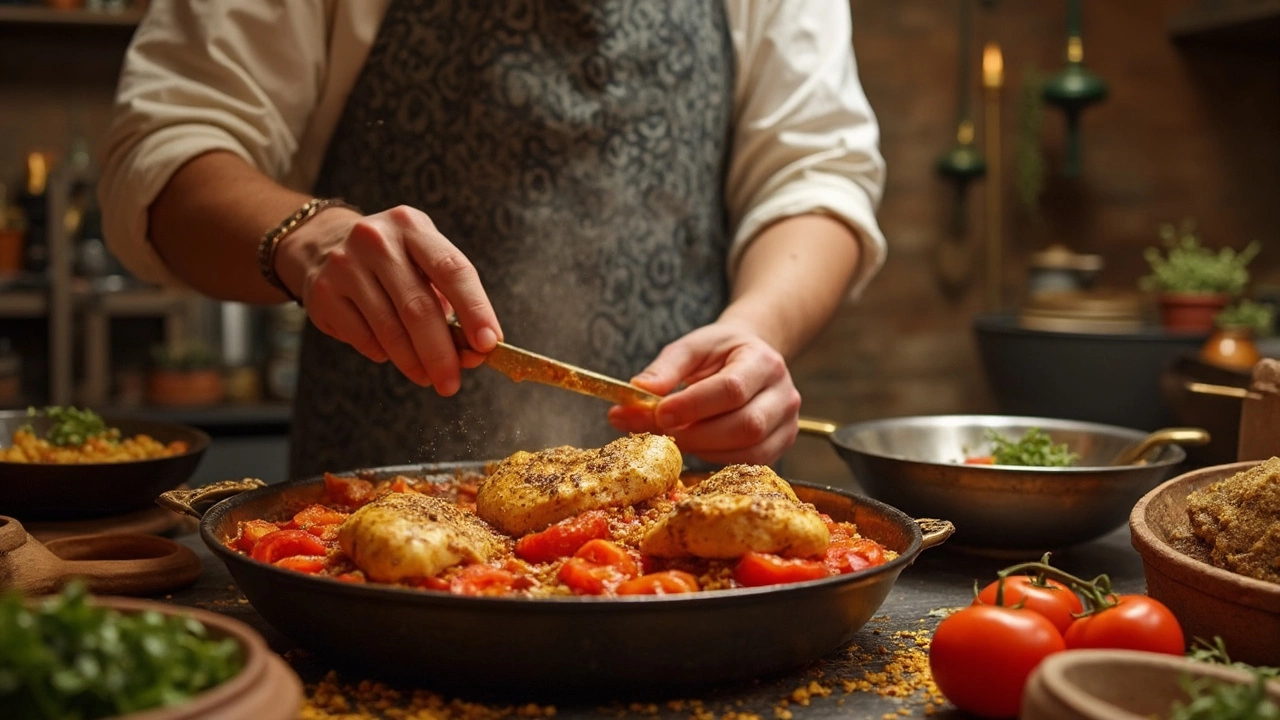Tomatoes in Curry: Spicing Up Your Chicken Dish

So, you’ve got your chicken, spices, and all the essentials ready for your curry. But then you pause—should you toss some tomatoes in there? It's a question that seems simple but can actually stir quite the debate among curry enthusiasts.
Tomatoes aren't traditionally used in every curry recipe, but when they do appear, they can add a whole new layer of flavor. Their natural acidity brings a bit of tanginess that can balance the richness of creamy ingredients like coconut milk or yogurt. Plus, they add a lovely touch of color to your dish—nothing wrong with a curry that looks as good as it tastes!
Let’s talk about varieties. Not all tomatoes are created equal in the curry world. Plum tomatoes are a popular choice due to their meaty consistency and low water content. Meanwhile, cherry tomatoes can add a pop of sweetness and freshness. Whichever you choose, remember to adjust the amount based on how tangy or sweet you want the curry to be.
Now, timing is everything with tomatoes. Add them too early, and they might dissolve away without leaving a trace. Too late, and they’ll overpower the entire dish. A good rule of thumb? Add them just after your onions have softened but before you pour in any liquids. Play around to see what suits your taste best.
Curry isn’t a one-size-fits-all dish, and neither is the use of tomatoes in it. Some regions embrace tomatoes wholeheartedly, while others prefer them to take a backseat or skip the party altogether. That’s the beauty of cooking—it allows for creativity and personal preference.
- The Role of Tomatoes in Curry
- Tomato Varieties to Consider
- Tips for Adding Tomatoes Successfully
- Regional Preferences and Variations
- Balancing Flavors in Your Curry
The Role of Tomatoes in Curry
When it comes to tomatoes in curry, they often divide opinion, but there’s no denying they play a significant role in reimagining this classic dish. Their inclusion can transform the texture and amplify the taste of your curry in surprising ways.
The Tangy Twist
Tomatoes introduce a bright, tangy twist to the curry that can lighten up heavier flavors. If your dish feels too creamy or oily, a bit of tomato can balance it out beautifully. Their natural acidity acts as a perfect counterpoint to the savory, and sometimes spicy, elements of curry.
Thickening and Texture
Beyond flavor, tomatoes contribute to the consistency of curry. Cooked down, they add thickness without the need for additional thickeners like cream or coconut milk. Moreover, they give the dish a smoother, more uniform texture, making each bite a harmonious blend of ingredients.
Rich in Nutrients
Nutritionally, tomatoes are rich in vitamins A and C, adding a healthy dose of nutrients to your curry. They're also packed with antioxidants like lycopene, which is said to have several health benefits. So, incorporating tomatoes isn’t just about taste—it’s a little boost to your diet too.
Versatility and Variety
The versatility of tomatoes allows them to adapt to different curry styles. Whether it’s a North Indian chicken curry or a South Indian variation, tomatoes can fit right in. Some folks even like to experiment with sun-dried tomatoes for a more intense flavor hit.
Here’s a quick look at how tomatoes can be used:
- Fresh Tomatoes: Add them early in the cooking process.
- Tomato Paste: Great for when you need a concentrated flavor kick.
- Canned Tomatoes: A handy option when fresh ones aren’t available.
Ultimately, the role of tomatoes may not be one-size-fits-all, but they certainly offer a delightful edge to your curry, making it a dish worth experimenting with.
Tomato Varieties to Consider
When it comes to picking the right tomatoes for your chicken curry, the variety you choose can truly impact the end result. Let’s break down some of the popular options and what they bring to the table.
Plum Tomatoes
Plum tomatoes are a go-to for many curry makers. They're known for their meaty nature and low seed count, making them ideal for sauces. Their thick walls help them hold their shape longer during cooking, providing more substance to your dish. If you're looking for something that can simmer nicely without turning mushy, plum tomatoes are your best bet.
Cherry Tomatoes
If you're after a burst of freshness, cherry tomatoes might be up your alley. They add a natural sweetness and a lovely pop to each bite. Keep in mind that they might break down a bit faster, so adding them later in the cooking process can help maintain their shape and flavor.
Roma Tomatoes
Similar to plum tomatoes, Roma tomatoes are often chosen for their rich flavor and lower moisture content. They offer a perfect balance between sweet and tangy, which can enhance the overall taste of your curry without overpowering other ingredients.
Heirloom Tomatoes
For those who love experimenting, heirloom tomatoes come in a variety of colors and flavors, offering a unique twist to your curry. While they can be juicier, they bring an interesting depth and are visually appealing, too. Just keep in mind that they can vary greatly in taste, so it might take some trial and error to get the perfect balance.
Choosing the right tomato isn’t just about the taste—it also affects the texture and consistency of your curry. Whether it's the reliable plum or the vibrant heirloom, each variety has distinct qualities that can make your dish that much more special. Try experimenting with these options to see what suits your curry preferences best!

Tips for Adding Tomatoes Successfully
Adding tomatoes to your curry might seem like a straightforward task, but getting it right can make a huge difference in flavor and texture. Here are some practical tips to ensure your tomatoes harmonize perfectly with every scoop of your chicken curry.
Choose the Right Type
Not all tomatoes are created equal when it comes to talking curry. Opt for plum tomatoes if you're looking for a deeper flavor and less water. They won’t make your curry too watery. Cherry tomatoes, on the other hand, add a sweet burst but might not give you the consistency you're looking for.
Timing Is Everything
You want to get your tomatoes in at just the right moment. Too early and they melt away; too late, and they're still whole. Usually, it’s best to add them after your onions are golden but before incorporating any main liquid ingredients.
Prepping Is Key
Peel and chop your tomatoes to avoid any unwanted texture. Peeling is especially important for those who don’t fancy bits of skin floating in their dish. A quick blanch in boiling water makes them easy to peel.
Balance Those Flavors
Tomatoes bring acidity, so consider your lineup of spices. If you're using tart spices or sour agents like tamarind, you might need to adjust. A pinch of sugar or dollop of cream can mellow things out if it's too tangy.
Taste As You Go
Always keep tasting your curry as it cooks. Each tomato batches its freshness, sweetness, and tang differently. It’s the best way to ensure everything’s coming together just how you like it.
Consider Regional Variations
Some regions swear by the mix of tomatoes and meat, creating a rich, deep flavor. Experiment to see what suits your palate and if a particular region's style captivates your taste buds.
| Type of Tomato | Flavor Profile | Best Used For |
|---|---|---|
| Plum | Rich and Less Watery | Thick Curries |
| Cherry | Sweet and Fresh | Light Curries |
With these tips, tomatoes can go from a simple ingredient to a star player in your dish. Adding them successfully gives your curry a worthy depth and complexity.
Regional Preferences and Variations
When it comes to chicken curry, the use of tomatoes varies a lot depending on where you are. Different regions have their own set beliefs about whether tomatoes should be an integral part of their recipes.
Indian Variations
In North India, you'll find that tomatoes are a staple, especially in dishes like butter chicken. They bring that rich, slightly sweet balance, complementing the spices perfectly. However, down south, the story shifts a bit. Here, curries such as Chettinad often use fewer tomatoes, relying more on coconut milk and tamarind for their zing.
British Influence
Over here in the UK, we have our own take on curry, thanks to a long history with Indian cuisine. Tomatoes have a firm place in British curries, like chicken tikka masala. The British version is a bit creamier and sweeter, with tomatoes enhancing that traditional richness.
Southeast Asian Twists
In places like Thailand or Malaysia, you might notice a reliance on ingredients like lemongrass and galangal for flavor, with tomatoes playing a supporting role or sometimes absent. These curries often prioritize elements like fish sauce or kaffir lime leaves for tang.
Just a Matter of Taste
No matter the region, the choice of using tomatoes in curry boils down to personal taste. Some regions use them liberally, while others prefer their curries with minimal or no tomatoes. The beauty of cooking curry is its flexibility - you can adjust the tomato level until it's just right for your taste buds!
| Region | Use of Tomatoes |
|---|---|
| North India | High |
| South India | Moderate |
| United Kingdom | High |
| Southeast Asia | Low to Moderate |

Balancing Flavors in Your Curry
Getting the right balance in your curry is like hitting the perfect note in music. You want each ingredient to harmonize, especially when adding tomatoes to the mix. They can be a star ingredient or a support player, depending on how you use them. But too much tang can overpower delicate spice blends.
Adjusting Acidity and Sweetness
When adding tomatoes, think about the other ingredients in your curry. If you've got a creamy base like coconut milk, the acid in tomatoes can be a perfect counterbalance. But if you're using yogurt, which is already tangy, you might want to go lighter on the tomatoes. Taste as you go—it’s your best guide.
Remember that sugar can balance acidity. If your tomatoes make the curry too tangy, a pinch of sugar can smooth things out. It's like tuning an instrument—small tweaks make a big difference.
The Role of Spices
Spices are the backbone of any curry, and they play a vital role in balancing flavors. Cumin, coriander, and turmeric should blend well with the tomatoes. If you’ve got a lot of acid from the tomatoes, a touch more cumin or adding mustard seeds can round out the flavor.
Step-by-Step Balance Tips
- Taste Your Base: Before adding tomatoes, taste your curry base and identify if it's sweet, spicy, or bland.
- Incorporate Gradually: Add tomatoes in stages. This way, you can control the intensity of the tang.
- Check for Balance: After incorporating, taste again and adjust with spices, sugar, or salt as needed.
A well-balanced curry leaves room for each flavor to shine. With a little practice, you’ll find tomatoes can bring out the best in your dish, transforming it from good to unforgettable.